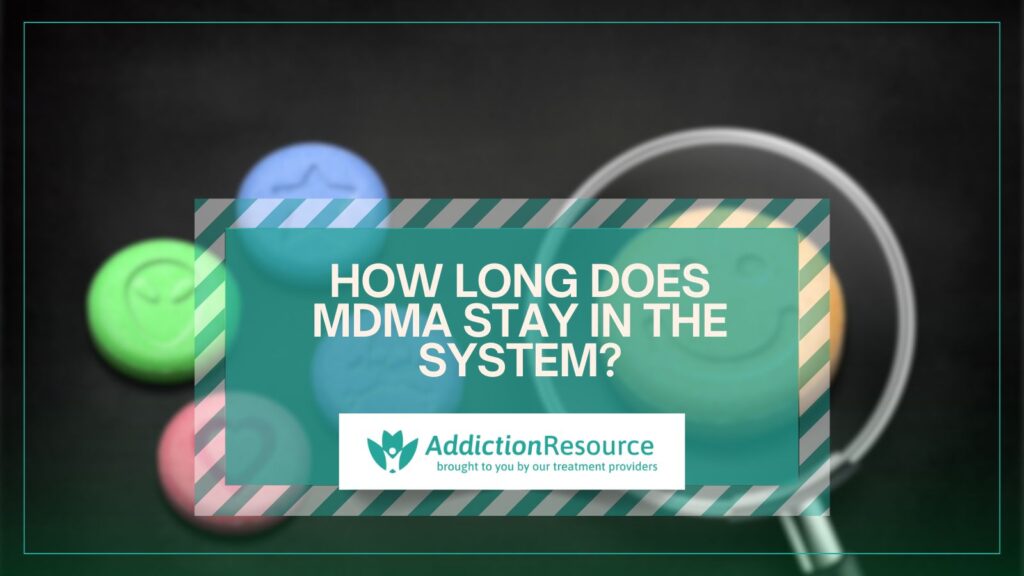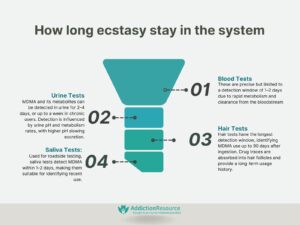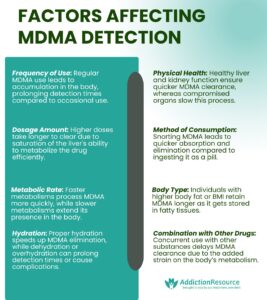
MDMA (3,4-methylenedioxymethamphetamine), also called ecstasy or molly, stays in the system for 1 to 5 days. The duration depends on the type of test used to detect molly. Urine tests detect MDMA for up to 2 to 4 days. Blood tests are effective for detecting MDMA within 1 to 2 days. Saliva tests show MDMA traces for 1 to 2 days, and hair tests provide the longest detection window and detect MDMA for up to 90 days. These detection timelines vary based on three important factors, including metabolism, dosage, and frequency of MDMA use, according to an article written by Tsadik T Abraham in 2011 titled “Urinary MDMA, MDA, HMMA, and HMA Excretion Following Controlled MDMA Administration to Humans.”
Table Of Contents:
Understanding how long MDMA stays in the system is important for three major reasons, including health risks, legal responsibilities, and the recovery process. The detection timeline helps to assess health risks related to drug interactions or their after-effects. Drug testing is required in situations like workplace screenings or legal proceedings. Knowing how long MDMA stays in the system helps people track their progress and stay consistent with their recovery process. Individuals make better choices about their health and remain aware of any legal responsibilities they have after understanding these detection timelines.
How the Body Processes MDMA?
The body processes MDMA by first absorbing it into the bloodstream through the stomach and intestines after it’s ingested. MDMA travels to the brain after getting into the bloodstream, where it produces its stimulating effects. MDMA leads to a greater release of serotonin and norepinephrine compared to dopamine and causes higher stimulant effects. Serotonin is a neurotransmitter that helps regulate mood, sleep, pain, appetite, and other behaviors. MDMA addicts experience mood-enhancing effects after the rise in serotonin caused by MDMA.
The liver plays a key role in breaking down MDMA by the cytochrome P450 system into smaller compounds that are then eliminated by the kidneys through urine. MDMA reaches peak concentrations in the bloodstream within 1 to 2 hours after use. Molly begins to clear from the system, with the effects wearing off within 4 to 6 hours. Molly traces remain in the system for several days, as it takes time for the liver to process and eliminate MDMA.
How Long Does Ecstasy Stay in Your System?
MDMA stays in your system for 1 to 5 days in your urine, blood, saliva, and hair. The detection timeline depends on the testing method used to detect MDMA.
A detailed overview of how long ecstasy stays in your system is written below.
- Urine: Urine tests are used to detect MDMA because they are non-invasive and identify the presence of both MDMA and its metabolites. MDMA is detected in urine for 2 to 4 days after last use. Molly is detected for up to a week in heavy or chronic MDMA users. Differences in urine pH influence how quickly MDMA is excreted from the body. Urine with a higher pH (more alkaline) is directly linked to a slower excretion rate, which means MDMA stays in the system longer. MDMA metabolites are present for longer periods in individuals with slower metabolism rates, according to an article written by Harold Kalantin in 2001 titled “The pharmacology and toxicology of “ecstasy” (MDMA) and related drugs.”
- Blood: Blood tests are more precise than urine tests but have a shorter detection window. MDMA is detected for 1 to 2 days after ingestion in blood. The blood detection window is shorter because MDMA is metabolized and cleared from the bloodstream quickly compared to other bodily fluids.
- Saliva: MDMA is detected in saliva for 1 to 2 days. Saliva tests are used in roadside drug testing and identify recent use of the drug. MDMA is quickly absorbed into the bloodstream, which makes blood tests the most effective method of detecting recent molly use.
- Hair: Hair tests detect MDMA for up to 90 days after last use and make it the most extended detection window. The hair detection method works by identifying traces of the drug that are absorbed into hair follicles over time. Hair grows at an average rate of about 1 centimeter (cm) per month, so when a hair test is used to detect MDMA, the segment of hair that tests positive reflects the time of ingestion. Hair tests provide a long-term history of MDMA use, according to an article written by Michael Rothe in 1997 titled “Hair concentrations and self-reported abuse history of 20 amphetamine and ecstasy users”.
What are the Factors That Affect MDMA Detection?
The factors that affect MDMA detection are frequency of use, dosage amount, metabolic rate, hydration, and physical health. Each of these factors has a direct impact on how long MDMA stays in the body and how quickly it is eliminated.
The 8 main factors affecting MDMA detection are listed below.
- Frequency of Use: Frequency of use means how frequently someone uses MDMA. Regular users of MDMA have longer detection times compared to occasional users because the drug and its metabolites accumulate in the body. The accumulation leads to slower MDMA clearance. Many users believe that Ecstasy makes them feel happy and allows them to keep going for days without rest. However, what they don’t realize is how dangerous Molly is.
- Dosage Amount: The higher the dose of MDMA taken, the longer it stays in the system. Larger doses take longer for the body to metabolize, which means it takes more time for the drug to clear from urine, blood, or saliva. High doses of MDMA saturate the ability of the liver to process MDMA efficiently, according to an article written by Ruff Joseph Macale Cajanding in 2019 titled “MDMA-Associated Liver Toxicity: Pathophysiology, Management, and Current State of Knowledge.”
- Metabolic Rate: The metabolic rate plays an important role in how quickly MDMA breaks down and is eliminated. People with faster metabolisms process and eliminate MDMA more quickly, while people with slower metabolisms retain traces of MDMA for a longer period. Metabolism is influenced by three main factors, including age, body composition, and genetics, according to an article written by J Clin Invest. in 2015 titled “Metabolic changes in aging humans: current evidence and therapeutic strategies.”
- Hydration: Hydration levels affect the speed at which MDMA clears from the body. Proper hydration helps to flush out MDMA metabolites more quickly through urine and stool. Dehydration slows this process down and leads to longer detection times. It is important to maintain a balance because excessive water intake leads to water intoxication, according to an article published by Medical News Today titled “What happens if you drink too much water?”
- Physical Health: A healthy liver and kidney affect how MDMA is metabolized and eliminated. Those with compromised liver or kidney function experience slower drug clearance, which results in extended detection windows. A healthy liver is important for breaking down MDMA into its metabolites, which are then eliminated through the urine and stool.
- Method of Consumption: The way MDMA is consumed affects how long it stays in your system. Drugs that enter the bloodstream more quickly are metabolized and cleared faster. Snorting MDMA allows it to reach the bloodstream faster than swallowing it as a pill, so it is eliminated more quickly when snorted compared to when ingested orally.
- Body Type: Body type refers to the physical characteristics of a person’s body, including body mass index (BMI) and body fat percentage. Most drugs, including Ecstasy and their by-products, are stored in fatty tissues. Individuals with a higher body mass index (BMI) or more body fat take longer to fully eliminate MDMA from their system, according to an article written by Danielle Barry in 2009 titled “Obesity and Its Relationship to Addictions: Is Overeating a Form of Addictive Behavior?”
- Combination with other drugs: Taking ecstasy in combination with other substances (intentionally or unintentionally) slows down the elimination process. The slowdown is because your body has to metabolize multiple medications at once, which saturates its ability to clear MDMA efficiently. The presence of other substances prolongs the time it takes for MDMA to leave your system, according to an article published by Healthline titled “How Long Does Molly (MDMA) Stay in Your System?”
What is the MDMA Half-life?
Ecstasy has a half-life of 8 hours, which means it takes the body 8 hours to eliminate half of the drug from the bloodstream. After one half-life, 50% of the initial amount of MDMA remains in the body. MDMA’s full clearance from the body takes 1 to 3 days. Multiple factors, including the dosage and individual characteristics of the person taking MDMA, affect how long it takes for the body to metabolize ecstasy. MDMA is metabolized relatively quickly and cleared from the system within a few days, but its effects last for 4 to 6 hours, according to a journal published by Clinical Neurology for Psychiatrists in 2013 titled “Neurotransmitters and Drug Abuse.”
What is MDMA Addiction?
MDMA addiction means compulsive and repetitive use of MDMA despite its harmful effects. Ecstasy, also called Molly, Adam, and XTC, is a synthetic drug created from lab-made chemicals. Molly boosts energy, enhances feelings of happiness, and promotes empathy toward others. Molly also comes with potential risks, ranging from muscle cramps and depression to more serious effects like heart failure. MDMA is not considered physically addictive, but it leads to psychological dependence. People who develop an MDMA addiction find it difficult to stop using molly. Frequent use of MDMA leads to tolerance, where MDMA addicts need higher doses of molly to achieve the same stimulant effects. Withdrawal symptoms such as depression, fatigue, and irritability occur when they stop using the drug, according to an article published by Medical News Today titled “MDMA: What you need to know about Molly.”
MDMA addiction develops when repeated use alters brain chemistry and affects serotonin levels. Molly causes a sudden release of serotonin, and the brain becomes dependent on the drug to maintain emotional balance. The dependence leads ecstasy users to crave the feeling of happiness it provides. Chronic ecstasy use damages serotonin-producing neurons and makes it harder for users to experience normal mood regulation without consuming molly.
Hope Without Commitment
Find the best treatment options. Call our free and confidential helpline
Most private insurances accepted
How to treat MDMA Addiction?
Treating MDMA addiction involves using therapy to recover both the mind and body, including cognitive-behavioral therapy, support groups, and outpatient treatment.
- Cognitive-behavioral therapy (CBT): Therapies, including cognitive-behavioral therapy (CBT), are helpful because there aren’t any specific medicines to treat MDMA addiction. CBT helps people recognize the reasons why they use MDMA and helps them in the recovery process.
- Support groups: Support groups offer a community of people who share similar struggles and provide encouragement. Some individuals experience uncomfortable withdrawal effects, such as fatigue, loss of appetite, depression, and difficulty concentrating, when they stop using ecstasy.
- Detox programs: Detox programs help manage withdrawal symptoms, including anxiety and fatigue. Psychiatric support is needed for mental health issues caused by MDMA, such as depression or irritability.
- Outpatient Treatment: Outpatient rehab allows users to live at home while attending treatment sessions one or more times per week. The outpatient treatment option is ideal if the user has a supportive home environment or needs less intensive care. A good treatment plan combines therapy, support, and lifestyle changes, which gives the best chance for a long-lasting recovery, according to an article published by the Center for Substance Abuse Treatment titled “Substance Abuse Treatment: For Adults in the Criminal Justice System.”
How Does Molly Work?
Molly (MDMA) works by increasing the release of three neurotransmitters, including serotonin, dopamine, and norepinephrine, in the brain. MDMA creates feelings of emotional warmth and empathy toward others. Ecstasy (MDMA) functions as both a stimulant and a hallucinogen and provides an energizing effect. MDMA alters time and perception and enhances the enjoyment of sensations.
How Long Does Molly Last?
Molly lasts 3 to 6 hours. The timeline depends on the dose and individual factors, including the frequency of doses, metabolism rate, and body mass and composition. Many MDMA addicts start to experience a euphoric high within 20 to 40 minutes, with the effects reaching their peak intensity around 90 minutes after MDMA ingestion.
Can I metabolize MDMA faster?
Yes, your metabolism affects how quickly MDMA is processed. People with faster metabolisms clear MDMA from their system more quickly. Younger, healthier, and more active individuals clear MDMA from their system more rapidly than older individuals. A healthy liver and kidneys (responsible for processing and eliminating substances) improve the metabolic process.
How Long do the effects of MDMA Last?
The side effects of MDMA last 4 to 6 hours, with the peak effects occurring within the first 2 hours. The initial MDMA effects begin within 20 to 40 minutes after ingesting MDMA. The peak is marked by intense feelings of euphoria, enhanced sensory perception, and emotional warmth.
Does Ecstasy Show Up on a Drug Test?
Yes, ecstasy (MDMA) shows up on drug tests, including urine, blood, saliva, and hair tests, depending on the time frames and type of test. Ecstasy is detected for up to 3 days in blood and saliva tests, up to 5 days in urine tests, and for months after the last use in hair follicle tests.
Find Drug Rehabilitation Centers Near You Anywhere In the US
Addiction Resource team has compiled an extensive list of the top drug rehabilitation facilities around the country. Use our locator tool to find the best centers near you.


 Reviewed by:
Reviewed by: 




 FindTreatment.gov
FindTreatment.gov